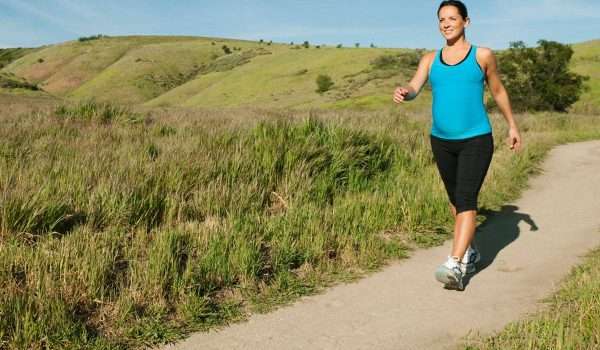 المشي تمرين رائع وآمن للأمهات الحوامل، وهو طريقة مثالية لممارسة الرياضة أثناء الحمل، حيث يُنشط المشي القلب والرئتين، دون إحداث ضرر على الركبتين أو الكاحلين، كما أنه نشاط سهل يمكن إدراجه بسهولة في الحياة اليومية، تابعي المقال التالي لمعرفة أهمية المشي للحامل في الشهور الاولى .
المشي تمرين رائع وآمن للأمهات الحوامل، وهو طريقة مثالية لممارسة الرياضة أثناء الحمل، حيث يُنشط المشي القلب والرئتين، دون إحداث ضرر على الركبتين أو الكاحلين، كما أنه نشاط سهل يمكن إدراجه بسهولة في الحياة اليومية، تابعي المقال التالي لمعرفة أهمية المشي للحامل في الشهور الاولى .
المشي للحامل في الشهور الاولى
الشهور الأولى من الحمل تكون وقت حرج يجلب العديد من التغييرات لجسم الحامل، وغالباً لا ترغب الحامل في ممارسة الرياضة بسبب الشعور بالإجهاد والغثيان، ومع ذلك فإن الرياضة الخفيفة مثل المشي خلال الشهر الأول من الحمل آمنة، وقد توفر بعض الراحة لبعض الأعراض المرتبطة ببداية الحمل.
أهمية المشي للتخفيف من أعراض الحمل في الشهور الأولى
التغيرات الهرمونية في الشهور الأولى من الحمل والمسؤولة عن نمو الجنين والمشيمة، يمكن أن تسبب مجموعة من الأعراض المزعجة، فقد تشعر بعض النساء بالدوار وضيق في التنفس، وقد تعاني الحامل أيضا انسداد الأنف، بالإضافة إلى الشعور بالتعب والغثيان، والحاجة المتزايدة للتبول، وممارسة الرياضة الخفيفة مثل المشي يساعد في التخفيف من أعراض الحمل في الشهور الأولى.
كيف يمكن الاستعداد للمشي أثناء الحمل؟
إذا كنتي تمشي بانتظام قبل الحمل، فاستمري في فعل ذلك، أما إذا كنتي جديدة في المشي، فابدأي بنزهة قصيرة لمدة 15 دقيقة ثلاث مرات في الأسبوع، وبمجرد أن تعتادي على المشي بانتظام، يمكنك زيادة مدة المشي حتى 30 دقيقة، لأربع مرات أو أكثر في الأسبوع، وإذا كان لديك مستوى لياقة عالي، فيمكنك المشي لفترة أطول من ذلك، فقط تأكدي من التوقف عند الشعور بالإرهاق، أو التوعك، أو الشعور بأي ألم.
يجب وضع واقي الشمس وارتداء قبعة إذا كنت تمشي في يوم مشمس، مع الحرص على أخذ زجاجة من الماء للمساعدة في منع الجفاف، حيث يمكن أن يؤدي الجفاف إلى زيادة درجة حرارة الجسم، وارتفاع درجة الحرارة ليس جيدًا لك أو لطفلك.
المشي طوال فترة الحمل
يُوصي بالمشي لمدة 150 دقيقة في الأسبوع طوال فترة الحمل، أي 30 دقيقة سيراً على الأقدام لخمس مرات في الأسبوع.
المشي للحامل في الشهور الاولى
يجب ارتداء أحذية مشي مريحة، لإعطاء القدم الدعم الذي تحتاجه، وعند المشي يجب وضع الكعب على الأرض أولاً، ثم أصابع القدمين بدلاً من وضع القدم مسطحة على الأرض.
المشي للحامل في الثلث الثاني من الحمل
تشعر الحامل بحيوية أكبر في الثلث الثاني من الحمل مقارنة بما تشعر به في الثلث الأول من الحمل، وقد يبدو المشي أكثر سهولة، وقد تتمكن الحامل حتى من زيادة مسافة المشي، ومع ذلك قد تشعر بمزيد من الصعوبة بعد أن يزداد حجم البطن.
المشي للحامل في الثلث الأخير من الحمل
المشي في الثلث الحامل على الرغم من أنه يمكن أن يمثل صعوبة بسبب حجم البطن الكبير، إلا أنه يشكل أهمية خاصة لأنه يساعد على الولادة الطبيعية وأن يأخذ الجنين وضعه الطبيعي الصحيح في الحوض.
وفي النهاية وبعد معرفتك لأهمية المشي للحامل في الشهور الاولى ، إذا كان لديك المزيد من التساؤلات أو الاستفسارات، يمكنك استشارة أحد أطبائنا من هنا.
اقرئي أيضا:
